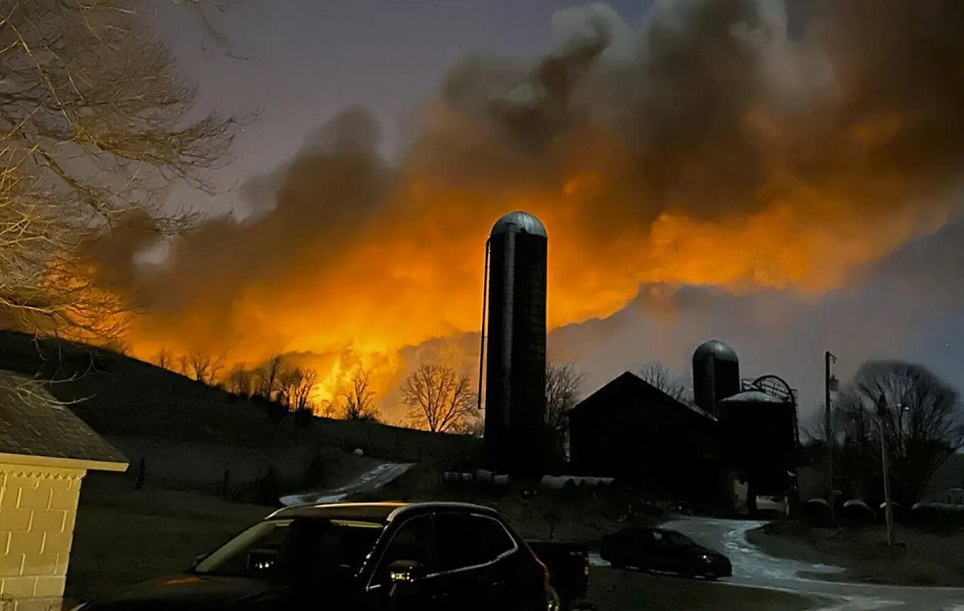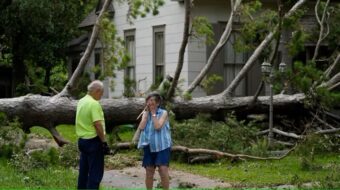
WASHINGTON—Even before 49 cars in its mile-and-a-half-long freight train derailed, crashed, and produced an environmental and physical disaster in East Palestine, Ohio, Norfolk Southern railroad had rampant safety problems, a new Federal Railroad Administration report says.
And workers noticed them.
On a one-to-seven scale of perceptions of safety, with seven being the best rating and one the worst, workers FRA interviewed gave Norfolk Southern a 4.38 grade. The most veteran workers, with 21-30 years experience, were even more down: 3.58.
By contrast, field-level supervisors gave their railroad an average rating of 6.27.
That’s even though an objective measure of safety—a chart of accidents per million train miles—showed Norfolk Southern’s record worsened every year from 2018-2022. Among the nation’s seven big Class I freight railroads, it’s now tied for worst, with five accidents per million miles, with Burlington Northern Santa Fe.
FRA released the report just after another federal agency, the Occupational Safety and Health Administration, agreed with the Teamsters on solving Norfolk Southern job safety and health violations at East Palestine. OSHA also fined the railroad $49,111.
Those violations sickened 39 Brotherhood of Maintenance of Way Employees/Teamsters members with nausea and migraine headaches. The railroad sent them to the site to clean up the mess after the February 3 crash.
Besides paying the fine, Norfolk Southern agreed to three other priorities in the wake of the East Palestine crash, where 11 cars filled with toxic chemicals were among those that derailed.
Meanwhile, the disaster and crisis continue for the people of East Palestine with some residents still sick and at least some who have returned home living in fear in houses they are now afraid to inhabit.
As late as last month there were reports of families still returning to their homes after four months in exile in hotels 20 to 80 miles away where they were charged as much as $250 to $300 a night, sometimes in facilities that lacked decent or acceptable conditions. Whole families, with children and dogs, were squeezed into tight little rooms, at times.
The New York Times reported yesterday on the return of a family that had been similarly exiled, forced to come back to their home a half mile from the burn site when their savings account dwindled to $49.
The night of the explosion a mother of three smelled burning plastic while in her backyard and when she went to the front of the house she was horrified by the sight of the flames. Mysterious health symptoms appeared among members of her family with her husband vomiting in the shower and the children having difficulty breathing. They fled to a hotel room 20 miles away in Pennsylvania. They moved back not because the health issues were resolved but because their money ran out.
The Ohio governor, Republican Mike DeWine, says the air and water are clean now and the Environmental Protection Agency says there is no evidence to suggest there is “contamination of concern.”
DeWine, of course, declared that everything was okay two days after the explosion so some don’t take him too seriously.
Despite the claims that all is well some 200 cleanup workers are still coming into East Palestine each day. According to the Times, there are 1.4 million gallons of contaminated water and 3, 300 tons of poisoned soil that still have to be removed and there are no official reports about the effects of this on the population of the town.
In June independent researchers said they found contamination remaining in buildings in the town and some still report symptoms that are connected to the explosion.
Still fear going in
Some residents and building occupants still say they cannot enter their buildings for more than a few minutes without getting headaches. Scientists are saying that many of the compounds generated in the fire are ones that regulatory agencies and public health officials are not experienced with.
For residents, the problems go beyond just worrying about the long-term effects of the toxic chemicals on their families. Due to the pile up of debt and the addition of emotional and other problems many are fearful of what will happen next in their lives. Where do they go from here?
None of these things are concerns for Norfolk Southern.
When DeWine declared everything OK almost immediately after the fires residents knew otherwise. Simple things one takes for granted every day, like the birds singing in the morning, had stopped. And even after they started singing again, who knows what the long-term effects are on those birds?
Among the first symptoms reported by people, were loss of appetite, nausea and breathing trouble. A group of researchers from Carnegie Mellon and Texas A&M University found dangerous levels of acrolein in the air, something the government and EPA detectors were not made to detect. Acrolein causes lesions in the lungs and damages nasal tissues.
The hand-held devices used to test for contaminants by Norfolk Southern did not test for this or for other contaminants responsible for health problems in East Palestine.
The inspectors sent in by the railroad are reported to have left after only ten minutes of testing because they could not tolerate the acrid odors in the town. Yet they reported that there was nothing to be concerned about.
The Times reported yesterday that a resident of East Palestine went on March 28 to Pittsburgh for an echocardiogram and got devastating results.
The percentage of blood being pumped out with each heartbeat was only 15 percent when it should have been 50 percent or higher. The man was fitted with a round-the-clock external defibrillator. The cardiologist, Dr. Matthew Lander, was confident that the chemicals and the stress had contributed heavily to his condition. “I would be hard-pressed to think this is not related,” he said in an interview.
Some in the town are saying everything is fine now while others say they still have symptoms. People want to believe everything is OK and some even say that those with symptoms might be faking them to get more compensation from the railroad. What can be said for sure, however, is that the negligence of a railroad got people sick, hurt them financially, and at the very least has now divided a town and its people and disrupted their peace and happiness, possibly for a long time to come.
When it comes to the workers affected, however, the unions are pretty clear about where they want to go with this. “We want to implement a medical surveillance program for all affected employees who worked at the derailment site,” said the Teamsters. They also want to “provide the railroad’s union employees with 40 hours of hazardous waste operations and emergency response training for future derailments” and they want to “create a training program on lessons learned” from East Palestine.
Norfolk Southern’s safety problems predate the crash, the FRA report shows. It’s based on post-crash inspections and interviews stretching over 60 days this year. The data and revelations date back beyond that. And while overall the report gives NS the equivalent of a “C” grade on safety, digging into the details paints a bleaker picture.
The FRA began probing Norfolk Southern after three workers suffered amputations—the report didn’t identify which limbs—in the last half of 2021. Two of the injured workers were conductors who had been on the job less than a year.
Uncovered a host of problems
The agency’s system-wide audit of Norfolk Southern during six months in 2022 uncovered a host of problems and prompted almost two dozen safety recommendations. NS did little or nothing about them, says this follow-up report, prompted by the East Palestine crash.
“FRA found the overall safety culture maturity at NS to be in the involving level, although individual NS safety culture elements may be leading or lagging,” FRA said. “Involving level” is the agency’s language for that C-like grade.
“This middle level of safety culture maturity reflects both the positive changes and renewed commitment shown by NS’s leadership to improve safety as well as the areas where NS continues to operate in a manner that is reactive and focused on compliance with minimum safety requirements of federal regulations and industry standards.”
The details, though, not only are bleak but show Norfolk Southern also shares some safety hazards common at all seven big Class I freight railroads.
One example was in a letter from Amit Ray, then the FRA administrator, to Norfolk Southern CEO Alan Shaw. In the March 28, 2022 letter—ten months before the East Palestine crash—Ray criticizes all the big railroads for switching their inspection systems for freight cars and brakes from visual inspections by trained carmen to inspections by other, and untrained, workers.
That switch could compromise safety, the report said. It did on the freight train, NS32, which crashed in East Palestine, news reports show.
Untrained workers inspected the freight cars’ brakes before NS32 began its journey eastwards. In Indiana, another set of workers inspected the cars. Pressed for time, they didn’t notice the flaws and cracks which produced the fire that broke an axle on one car, derailing it and the rest.
That wasn’t all.
“In response to audit recommendations related to track safety, NS stated they would take no further action because the recommendations were beyond the minimum regulatory requirements,” the report adds. “FRA has not noted any subsequent change in NS’s position and will continue to reiterate those recommendations as FRA believes implementing these recommendations is important for improved safety outcomes.”
And Norfolk Southern had a deficient system for alerting train crews in time to hazards, especially those involving tank cars carrying hazardous chemicals.
Among seven problems with the alert system, the railroad “relies on emails from” the main monitoring desk “to dispatchers, which could slow down vital communication, such as receiving wayside detector reports.” The railroad’s “personnel policy”—there’s only one person at a time at the main monitoring desk—“poses a risk of delays or disruptions.”
And NS trains the conductors for hazard inspections for only 13 days. That’s not enough “and does not meet the demands of Class I railroad operations” or federal rules. The training “is deficient in oversight,” too.
There were so many problems at Norfolk Southern that despite the “C” grade at the beginning, the report reached a harrowing conclusion:
“Taken as a whole, this safety assessment also shows numerous examples where NS seems more concerned with compliance with minimum safety requirements of federal regulations and industry standards rather than understanding and seeking to address safety concerns that fall outside the boundaries of existing rules and regulations.”
We hope you appreciated this article. At People’s World, we believe news and information should be free and accessible to all, but we need your help. Our journalism is free of corporate influence and paywalls because we are totally reader-supported. Only you, our readers and supporters, make this possible. If you enjoy reading People’s World and the stories we bring you, please support our work by donating or becoming a monthly sustainer today. Thank you!













Comments